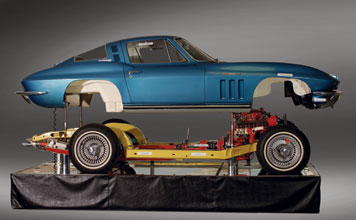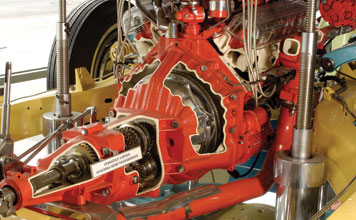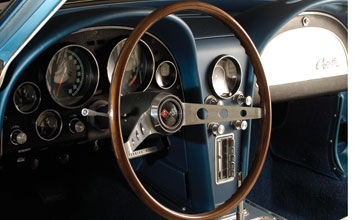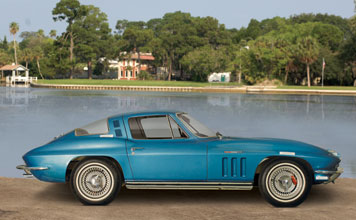1965 Chevrolet Corvette Cut-Away Autorama Display
The following listing is from RM Auctions detailing the 1965 Chevrolet Corvette Cut-Away Autorama display that sold at auction for $704,000. This auction took place between November 30, 2007 to December 1, 2007.
 |
 |
 |
 |
LOT: 859
Estimate:
$600,000-$800,000 US
Offered Without Reserve
AUCTION RESULTS: Lot was Sold at a price of $704,000
Specifications:
375hp, 327 cu. in. fuel-injected V8 engine, M-20 four-speed manual transmission, four-wheel independent suspension, and four-wheel disc brakes with four-piston calipers. Wheelbase: 98"
In the winter of 1953, thousands of show goers who were fortunate enough to attend General Motor's Motorama presentation at the Waldorf=Astoria in New York, were wowed by a little white fiberglass sports car taking center stage. It was the all new Corvette from Chevrolet. Never before had a member of the "Big Three" from Detroit created such a car.
Dramatic changes shaped the world over the next decade, during which time the little sports car similarly evolved, becoming an icon of American ingenuity, progress, performance, style, and design. Shepherded by the late, great Zora-Arkus Duntov, the Corvette not only looked good, but also out-performed nearly every other car on the road. By the end of the 1950s, the name 'Chevrolet' was nearly synonymous with Corvette in the popular consciousness.
For 1963, the Corvette legend would see a whole new look, one that immediately eclipsed the original in style and performance, and appealed to an even wider customer base. Stingray was all the rage, with its sleek streamlined looks courtesy of GM's design team lead by Bill Mitchell. For the first time, one's Chevrolet sports car could be had either as an open-air roadster or a comfortable enclosed coupe.
Innovations ensued from the engineering and design teams and, after the success of the first Stingray, only a few minor touches were deemed necessary for the 1964 model year. More options were found under the hood, resulting in more power from the small-block 327 cubic inch V8, that, when tweaked and injected, could belt out up to 375 horses. Additional improvements were well funded by Chevrolet and, as a result, sales continue to grow.
The third year of this body style looked quite similar to its two predecessors - a graceful, wind-cutting design, a snug comfortable interior, and ever-growing choices of power from under the hood. A closer look revealed a revised hood, new grille, and for the first time, functional venting in the front fenders, which all represented marked improvements over previous models.
One of the marketing department's biggest concerns was attracting potential customers to its displays at popular cars shows and the corporate-sponsored Motoramas held nationwide. While the Corvette was certainly an appealing showpiece in its own right, they realized that its 'look' was three years old and could benefit from revision. The result was, quite simply, a mechanical marvel.
To start with, they selected a very early model year 1965 Corvette coupe taken right from the assembly line. Finished in Le Mans Blue, and fitted with the white leather seats, this car was then shipped to a specialty company that produced dramatic and attention-grabbing exhibits for commercial and industrial shows. The car was immediately disassembled and meticulously operated upon to create a one-of-a-kind Corvette.
Mounting the body to elevating rams, the coupe would magically levitate off the chassis, leaving exposed all the car's major running gear. To further expose the inner workings of this machine, careful and well thought-out incisions were made in all of the major components.
With the push of a button, the body lifted up nearly two feet to showcase a custom finished chassis painted in light yellow. The exterior of the engine, transmission, and other mechanical parts were finished in bright red. Under the hood rested the very powerful 375-horse fuel-injected 327 cubic inch engine. The heads received custom-made, transparent valve covers while careful incisions were made on the most critical parts including the injection unit, exhaust, intake manifolds, and the block itself.
After the body rose, a series of electrical motors and gears put the car into action. Every moving component on the road-going Corvette was replicated on this display. It was geared to operate at just a few revolutions per minute rather than the break-neck thousands of a real car. Observers could thereby watch exactly how the small block engine operated; the turning cam pushed the corresponding intake or exhaust valve while the crankshaft pushed each piston to and fro. The engine was mated to a rock-solid M-20 four-speed manual transmission. As with the engine, cuts in its casing were made, showing the mounting of the clutch and flywheel. The moving driveshaft was painted red to match the rest of the critical ingredients, the U-joints were brightly plated and attached to the Posi-traction rear axle where the wheels spun and moved to activate the rear suspension and demonstrate just how well these cars handle and grip the road.
Among the many other features exposed to onlookers, the muffler's exhaust chambers, the construction of the chassis, and the right front disc brake were all given the cut-away treatment. Informative placards throughout the car explained the operations of many of the components and, to a certain degree, justified the Corvette's performance superiority over its competitors.
Far from being a made-up unit with parts resembling a real Corvette, this unique display started life, albeit ever so briefly, as a fire-breathing, fuel-injected Stingray coupe. After leaving the show circuit its exact history is unknown, but it was found in the mid-1990s in South Africa and returned to the United States. Since joining the Wiseman Collection, the car has received a sympathetic restoration. Its white interior, accented in blue, looks to have never been used. All of the original instrumentation including speedometer, tachometer, gauges and even the AM/FM radio and teakwood steering wheel, are still in the car. In fact, one of the only items not in the car that would be in a functional unit is the gearshift knob, which was removed to allow for the body to lift during demonstrations. The car is still fitted with its original white sidewall “Rayon” cord tires. In present condition, all of the mechanical demonstrations are in working order, including the initial lifting of the body, which is accomplished by the simple push of a button.
The Cut-Away Corvette Autorama display would undoubtedly make for an unbeatable showpiece to complement any complete Stingray collection. While many attempts have been made throughout automotive history to accurately represent a car's inner mechanicals in running order, it is truly unusual to find such a complete and flawless display. It is even more unusual to find one of these historic exhibits available for personal acquisition and private use and exposition. Addendum
Please note that this vehicle is offered on a Bill of Sale Only.
Contact Information:
RM Auctions, Inc.
t: 519-352-4575 f: 519-351-1337